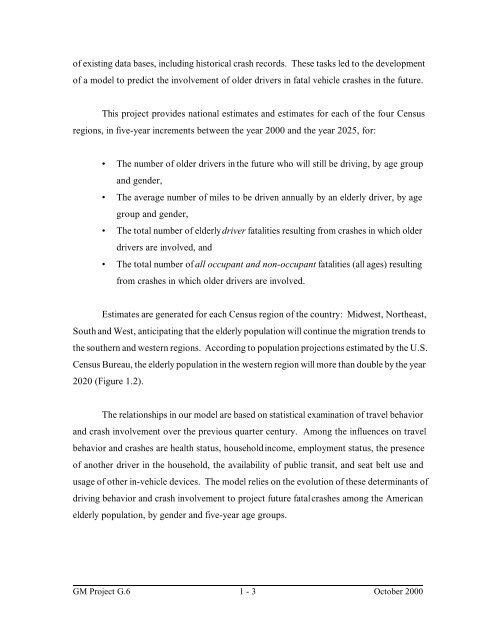Projecting Fatalities in Crashes Involving Older Drivers, 2000-2025
Projecting Fatalities in Crashes Involving Older Drivers, 2000-2025
Projecting Fatalities in Crashes Involving Older Drivers, 2000-2025
You also want an ePaper? Increase the reach of your titles
YUMPU automatically turns print PDFs into web optimized ePapers that Google loves.
of exist<strong>in</strong>g data bases, <strong>in</strong>clud<strong>in</strong>g historical crash records. These tasks led to the development<br />
of a model to predict the <strong>in</strong>volvement of older drivers <strong>in</strong> fatal vehicle crashes <strong>in</strong> the future.<br />
This project provides national estimates and estimates for each of the four Census<br />
regions, <strong>in</strong> five-year <strong>in</strong>crements between the year <strong>2000</strong> and the year <strong>2025</strong>, for:<br />
• The number of older drivers <strong>in</strong> the future who will still be driv<strong>in</strong>g, by age group<br />
and gender,<br />
• The average number of miles to be driven annually by an elderly driver, by age<br />
group and gender,<br />
• The total number of elderly driver fatalities result<strong>in</strong>g from crashes <strong>in</strong> which older<br />
drivers are <strong>in</strong>volved, and<br />
• The total number of all occupant and non-occupant fatalities (all ages) result<strong>in</strong>g<br />
from crashes <strong>in</strong> which older drivers are <strong>in</strong>volved.<br />
Estimates are generated for each Census region of the country: Midwest, Northeast,<br />
South and West, anticipat<strong>in</strong>g that the elderly population will cont<strong>in</strong>ue the migration trends to<br />
the southern and western regions. Accord<strong>in</strong>g to population projections estimated by the U.S.<br />
Census Bureau, the elderly population <strong>in</strong> the western region will more than double by the year<br />
2020 (Figure 1.2).<br />
The relationships <strong>in</strong> our model are based on statistical exam<strong>in</strong>ation of travel behavior<br />
and crash <strong>in</strong>volvement over the previous quarter century. Among the <strong>in</strong>fluences on travel<br />
behavior and crashes are health status, household <strong>in</strong>come, employment status, the presence<br />
of another driver <strong>in</strong> the household, the availability of public transit, and seat belt use and<br />
usage of other <strong>in</strong>-vehicle devices. The model relies on the evolution of these determ<strong>in</strong>ants of<br />
driv<strong>in</strong>g behavior and crash <strong>in</strong>volvement to project future fatal crashes among the American<br />
elderly population, by gender and five-year age groups.<br />
GM Project G.6 1 - 3 October <strong>2000</strong>
















